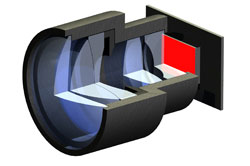Mini-beamer in a cell phone or PDA

Today, a choice has to be made whether to stay by the lake or watch the match on a big public screen or the TV set at home. In future, barbecue enthusiasts and football fans will be able to enjoy both at the same time. Cellphone TV is coming closer and with an innovative mini beamer it will be possible to create a public viewing event on a small scale – for example on a white bathing towel by the side of a lake.
The mini projector was developed by research scientists at the Fraunhofer Institute for Applied Optics and Precision Engineering IOF in Jena in cooperation with their partners in the EU project HYPOLED. Unlike conventional beamers it does not need an additional illumination system. Because the beamer can operate without an extra light source it offers a number of advantages: Firstly, it takes up little space. The prototype is 2.5 centimeters long, has a diameter of 1.8 centimeters and can be easily integrated in a cellphone or a PDA. Secondly, the device needs very little energy and therefore does not overtax the battery.
“The key component of the projector is an organic display, or OLED, developed by our colleagues at the Fraunhofer Institute for Photonic Microsystems IPMS in Dresden,” says Dr. Stefan Riehemann, group manager at the IOF. Currently the OLED display produces a monochrome image with a brightness of 10,000 candelas per square meter; for color images the brightness is about half that level. By way of comparison, a computer monitor generates about 150-300 candelas per square meter.
A lens system projects the image produced by the OLED onto a wall or other flat surface. The lenses are made of glass but the research scientists are already developing an optical system which uses plastic lenses. As plastic lenses can be embossed, they can be produced in larger quantities more simply and cheaply than glass lenses. At the Laser World of Photonics trade show from June 15 to 18 in Munich, the researchers are exhibiting a monochrome prototype (Hall B2, Stand B2.421).
Media Contact
More Information:
http://www.iof.fraunhofer.deAll latest news from the category: Physics and Astronomy
This area deals with the fundamental laws and building blocks of nature and how they interact, the properties and the behavior of matter, and research into space and time and their structures.
innovations-report provides in-depth reports and articles on subjects such as astrophysics, laser technologies, nuclear, quantum, particle and solid-state physics, nanotechnologies, planetary research and findings (Mars, Venus) and developments related to the Hubble Telescope.
Newest articles

A universal framework for spatial biology
SpatialData is a freely accessible tool to unify and integrate data from different omics technologies accounting for spatial information, which can provide holistic insights into health and disease. Biological processes…

How complex biological processes arise
A $20 million grant from the U.S. National Science Foundation (NSF) will support the establishment and operation of the National Synthesis Center for Emergence in the Molecular and Cellular Sciences (NCEMS) at…

Airborne single-photon lidar system achieves high-resolution 3D imaging
Compact, low-power system opens doors for photon-efficient drone and satellite-based environmental monitoring and mapping. Researchers have developed a compact and lightweight single-photon airborne lidar system that can acquire high-resolution 3D…





















